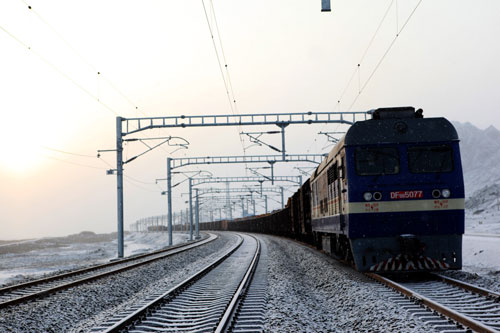Border town links east and west
Updated: 2011-12-09 16:23
By Shao Wei (China Daily)
|
|||||||||||
Investment in transport hub aims to increase frontier's trade role
ALATAW, Xinjiang - Once bleak and uninhabited, Alataw Pass, the country's largest land port of entry, is getting rich.
|
 |
|
A freight train arrives in Alataw, Xinjiang Uygur autonomous region. High trade volumes of food, textiles, garments, shoes and chemical products travel through Alataw Pass, which has rail and highway links and oil pipelines.[Photo/China Daily] |
People gather in the town on the China-Kazakhstan border, which lies on the western-most point of Northwest China's Xinjiang Uygur autonomous region, to engage in trade, tourism and shopping,
Saligy, a 42-year-old driver from the Republic of Kazakhstan, was waiting one day recently at the entry and exit building of the Alataw Pass. His cargo truck, carrying 23 tons of groceries, was parked outside the building.
"I drive the truck back and forth between China and Kazakhstan three times a month, and I can earn about 5,500 yuan ($864) to 6,000 yuan from each one-way trip," said Saligy, who has been taking cargo across the border for 15 years.
"Great changes have taken place and more people come to do business here."
High export volumes of Chinese food, textiles, garments, shoes and chemical products travel through the Alataw Pass, which has rail and highway links and oil pipelines. Imports of rolled steel, crude oil and leather products come in from central Asian countries.
The trade hub has been in operation since June 1990.
Thanks to the implementation of the Western Development Strategy and the opening of the Europe-Asia transcontinental railway, Alataw has become a major trading facility in West China.
It handled 25.2 million tons of cargo in 2010, making up 90 percent of Xinjiang's total port cargo volume, valued at $11.9 billion. It reported 10.4 billion yuan of customs tax revenue.
Before the 1990s, Alataw could barely support plant life, let alone humans, said Jurat Abdukerim, director of the managerial committee of the Alataw Pass.
Now, the Alataw Pass has more than 10,000 permanent residents and a transient population of about 20,000, Jurat said.
Jurat attributed Alataw's prosperity to the central government's strategy of "building a grand passageway in the northwest of China and turning Xinjiang into a bridgehead fully opened to the west".
The State Council approved the establishment of a bonded zone at the Alataw Pass in May. The zone, covering 5.6 square kilometers (sq km) in the Mongolian autonomous prefecture of Bortala in Xinjiang, is the 16th of its kind in the country.
The first phase of the 800 million yuan project, covering 2.96 sq km, is scheduled for completion by year-end.
With the new bonded zone, the Alataw Pass will evolve into a comprehensive free-trade zone with trade, processing and logistics services, said Jurat.
Although a large amount of imported cargo passes through the port every day, less than 1 percent of the imports are processed in the port area and only 50 percent are processed in Xinjiang, he said.
As a result, the transport-oriented economy has brought little economic benefit or regional development to the Mongolian autonomous prefecture of Bortala or to Xinjiang.
"Upon its completion, imports in the area will be bonded, and taxes on industrial value-added and consumption will be waived," he said. That will provide incentives for processing and logistics companies to base themselves in the area.
Xueke Tannery Co Ltd, a private company specializing in producing and selling certain types of leather, is one of the few processing companies based in Alataw.
With facilities covering more than 70,000 sq m, Xueke Tannery has the capacity to process 800,000 cow hides a year, as well as 1.6 million sheepskins.
"We have had a steady supply of raw materials from Uzbekistan, Turkmenistan, Tajikistan and Kazakhstan," said Wang Zhaomin, Xueke's general manager.
"After preliminary processing at Alataw, our products will be sent to inland provinces for shoemaking.
"Our products are in short supply, while a shortage of labor is the main obstacle for the company's expansion."
People are not willing to settle and work in Alataw because of the harsh climate, which experiences about 200 windy days a year, Wang said.
As a port of entry, "Alataw is not designated as either a city or a town. There is a big gap between the port's development and input in social undertakings ... such as money, education and medical treatment", Jurat said.
"More support from the State in policy and investment is still needed."
Alataw's growth mirrors the progress and challenges of foreign trade and outward-looking economic development in Xinjiang, Wang Ning, director of the Economic Research Institute at the Xinjiang Academy of Social Sciences, said.
While Xinjiang has great advantages in developing foreign trade and its economy, it lacks a sustainable driving force, she said. There is a long way to go for Xinjiang to become "a bridgehead fully opened to the west".
Xinjiang, which covers one-sixth of China's land mass, borders key countries such as Russia, Kazakhstan and Pakistan. The region also holds abundant oil and natural gas reserves. But regional economic activities have been constrained by poor infrastructure along the border.
Official figures show China's trade with Russia, Kazakhstan, Kyrgyzstan, Tajikistan and Uzbekistan reached $86.8 billion in 2010, up more than sevenfold since 2001.
Xinjiang's trade volume with Central Asia reached $4.48 billion in the first quarter of 2011, up 65 percent year-on-year. Trade with Kazakhstan reached $2.7 billion, up 60.3 percent year-on-year.








